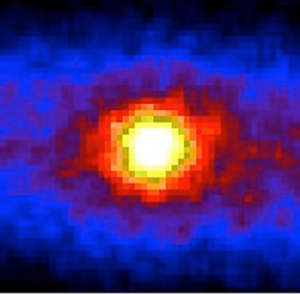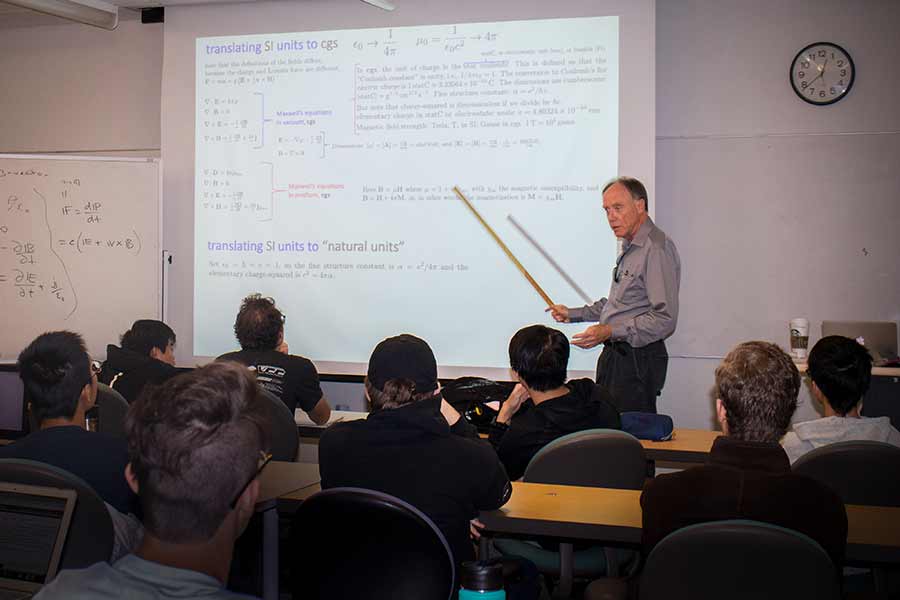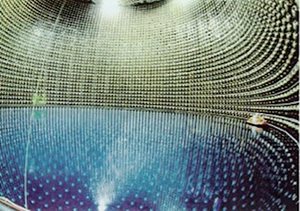
By:
- Lisa Petrillo
Published Date
By:
- Lisa Petrillo
Share This:
The Secrets of Ghost Particle Hunting

Scientists in Japan run a giant neutrino ghost particle catcher called Super-K deep underground in a mine utilizing 100 kilotons of water. Image credit: Kamioka Observatory, ICRR (Institute for Cosmic Ray Research), The University of Tokyo.
Every day is Halloween for physicist George Fuller, director for the Center of Astrophysics and Space Sciences at UC San Diego and one of the world’s leading “ghost” hunters.
Fuller, a distinguished professor of physics at the university, has made his life’s work chasing down subatomic particles called neutrinos that are so mysterious they’re known as ghost particles. These ghosts are known to exist even though they’re virtually invisible, they can’t be touched and they remain little understood.
So why do these dinky ghosts matter? They have been zooming around planet Earth since the Big Bang nearly 14 billion years ago, yet they were first revealed only in the 1930s. According to Fuller, they are so central to understanding the universe that their discovery has merited Nobel Prize awards. “By the ’50s, it was clear that you couldn't understand anything in physics without this particle,” he said.
The Halloween untreat
What makes neutrino ghost particles so special? “They have no electric charge, they have very small masses and we don't know what those masses are,” Fuller explained. "Still, we know they’re tiny. But we do know the differences of the squares of the masses.”
It’s also known that neutrino ghost particles come in three varieties that physicists call “flavors”: electron, muon, and tau. And they’re plentiful. “Given the number of ghost particles zipping about, you’re eating them whether you want to or not. Through every quarter centimeter of your body, 10 billion neutrinos per second are coming from the sun.”
Fuller became hooked on cracking the secrets of nature’s tiniest ghosts since first studying them in the 1970s and ’80s while attending California Institute of Technology for his undergraduate and graduate degrees because of how absolutely “odd” they are, behaving unlike any other element.

George Fuller emphasizes a point while teaching. Photo by Tatiana Diaz-de-leon
“I’m a theoretical physicist, so I look at what mysteries might remain about neutrinos and try to understand how neutrinos operate in core-collapse supernovae and in the early universe,” Fuller said. His research focuses on studying the neutrino-rich environment of such dramatic astronomical phenomenon as supernovae, the intense bursts caused by the violent explosion and ensuing rocket-fast collapse of a massive star.
Come Halloween, Fuller can share his passion for tracking ghost particles in the season when people find the mysterious entertaining. Now more than ever he’s gained lots of company in the ghost field. There has been a revolution on the experimental and observational side of neutrino physics over the last decade, he observes, producing research revealing answers about many properties of these particles. Finding out more about how they work may give insights into outstanding mysteries in the cosmos, he said, like the origin of the heaviest elements or the nature of dark matter.
Power in numbers
Grant funding has increased for neutrino research, including the $4.5 million from the National Science Foundation that Fuller received for a five-year project. It’s a first-of-a-kind approach that pools resources of three hub universities—UC San Diego, UC Berkeley and University of Washington—and is fortified by researchers and post-doctoral students from some eight collaborating institutions. Together in 2016, they launched the Network for Neutrinos, Nuclear Astrophysics and Symmetries (N3AS).
While Fuller has received many research grants during his 30-year career, he said most grants for himself and other physicists didn't allow hiring of more advanced research fellows at the postdoctoral level. Now, utilizing the shared brainpower of the N3AS, the three hub hosts have expanded their research collaboration to institutions that include: North Carolina State University; Northwestern; Ohio University; Los Alamos National Laboratory and the universities of Kentucky, Minneapolis, Notre Dame and Wisconsin.
Their consortium of postdoctoral fellows spends two years working at collaborating institutions and returns to one of the three hubs for a third year or more. With researchers and co-PIs in frequent collaboration, they've created a dynamic cross-pollination of neutrino and cosmology research. The consortium mission is to train a new generation of researchers in the three interdisciplinary areas important to astrophysics and cosmology—neutrino flavor physics, dark matter and the properties of dense nuclear matter important to neutron star structure.
“With N3AS, we crafted it in this way to maximize the postdocs,” Fuller explained. “We hope to expand and upgrade the program into a physics frontier center.”
Global ghost hunt is on

The sun in neutrinos composite from Super-K in Japan. Image credit: Kamioka Observatory, ICRR (Institute for Cosmic Ray Research), The University of Tokyo
Neutrino research is a global hunt. Scientists have developed giant detecting machines almost out of Jules Verne tales. Scientists in Japan created the Super-Kamiokande, or Super-K, that captures neutrinos from a mine 3,300 feet underground surrounded by 100 kilotons (50,000 tons) of water in a domed tank with walls covered with some thousands of light sensors. A more modern machine called IceCube sits inside an ice field in Antarctica with 5,000 blue-light sensors to detect neutrinos from the sun and space.
From his perspective, Fuller sees an explosion of interest in neutrino physics because of its fundamental overlap with cosmology and frontier issues and particle physics. “And now we have this new vehicle to explore that interest in that science, utilizing the N3AS consortium,” he said.
Star struck
Fuller enjoys the training aspect of his research work, and considers himself lucky to have been taught by some of the giants in this field, including physics legends and Nobelists Richard Feynman and William A. Fowler, a pioneer in nuclear and particle astrophysics. Fuller went on to win the prestigious Hans Bethe prize, named for the late Nobel laureate, by the American Physical Society in 2013.
Fuller discovered his fascination for ghost hunting as a boy growing up in the San Fernando Valley, where he turned from his backyard telescope on the light-polluted skies to find his inspiration from the astronomical science fiction of TV’s Star Trek in the 1960s. When the intrepid explorers on the Space Ship Enterprise discussed the concept of anti-matter on an episode he still recalls, young Fuller declared the plot line ridiculous. Still, he hit the library to research the concept, and so first learned of the power of sub-atomic particles. He was hooked.
Does he believe in ghosts for real? He declines to speculate beyond only what can be seen, although he says firmly, “I believe in neutrinos.”
Share This:
You May Also Like
Stay in the Know
Keep up with all the latest from UC San Diego. Subscribe to the newsletter today.


